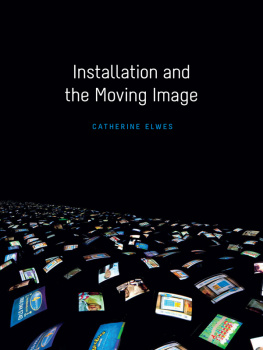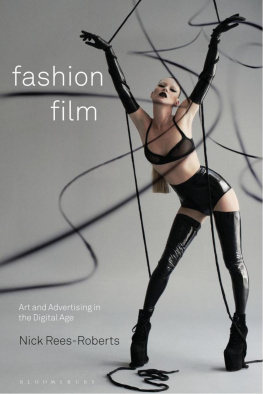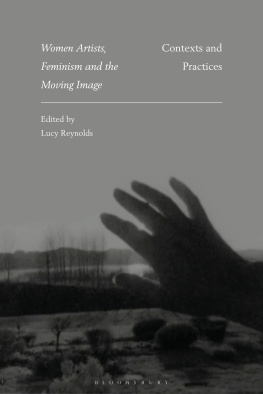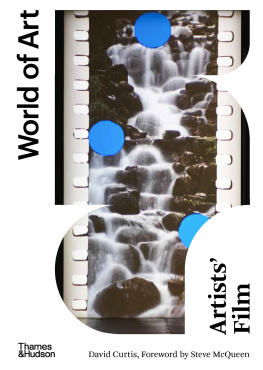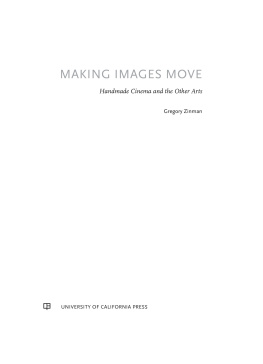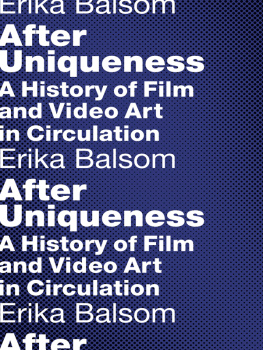INSTALLATION AND THE MOVING IMAGE
Installation and the Moving Image
CATHERINE ELWES
A Wallflower Press Book
Published by
Columbia University Press
Publishers Since 1893
New York Chichester, West Sussex
cup.columbia.edu
Copyright Catherine Elwes 2015
All rights reserved.
E-ISBN 978-0-231-85080-3
Wallflower Press is a registered trademark of Columbia University Press
Cover image:
David Hall, 1001 TV Sets (End Piece) (19722012). Installation view, Ambika P3 gallery, London. Courtesy of the artist.
A complete CIP record is available from the Library of Congress
ISBN 978-0-231-17450-3 (cloth : alk. paper)
ISBN 978-0-231-17451-0 (pbk. : alk. paper)
ISBN 978-0-231-85080-3 (e-book)
A Columbia University Press E-book.
CUP would be pleased to hear about your reading experience with this e-book at .
Contents
For Willow and Matthew
Many individuals, both academics and practitioners have contributed their wisdom and experience to the project of this volume. I am particularly indebted to Colin Perry who edited the first draft, challenging my more outlandish assertions and nuancing my arguments. A key conversation with David Dibosa helped to formulate a plan at an early stage and Murray Smith, John Tchalenko and Tim Smith generously provided expertise in the field of cognitive science over an extended period, while Chris Wright clarified key points relating to anthropology. To fill gaps in my knowledge, I have often appealed to film and video historians and these include the late A.L. Rees, Sean Cubitt, Ian Christie, Pryle Behrman, David Curtis, Lucy Reynolds, and Eu Jin Chua whose definition of ontology is permanently pasted to my wall. Duncan White generously gave me access to unpublished research, as did William Raban and Mario Slugan, while David Hendy provided me with recordings of his BBC broadcasts. Many exchanges with artists have clarified issues of practice. In this respect, I am particularly grateful to the late David Hall, Chris Meigh-Andrews, Steven Ball, Chris Welsby, Annabel Nicolson, Laura Mulvey, William Raban, Simon Payne, Nicky Hamlyn, Tom Sherman, Susan Collins, Ken Wilder and Tim Head. I learned a great deal from the participants of the AHRC Artists Moving Image Research Network events at the University of the Arts London (UAL), as well as the contributing authors and editors of the Moving Image Review & Art Journal (MIRAJ). My warmest thanks are due to Erika Balsom who took over the editorship of the journal while I wrote up the final draft of the book. I have enjoyed the support of the research team at the CCW Graduate School, UAL including Oriana Baddeley, Malcolm Quinn, Matthew Whyte, Sarah Kate Wilson, Laura Lanceley, Claire Mokrauer-Madden and Wendy Short. My research students, Kate Pelling, Catherine Long, Genevieve McGill, Fay Hoolahan and Jeff Langille have led me to new areas of scholarship. Yoram Allon and his team at Wallflower Press have been consistently encouraging, helpful and patient.
Friends including Nina Danino, Amikam Toren, Judith Rugg, Joanna Gilmour, Pat Matheson, Katharine Meynell and the late Anna Morpurgo-Davies provided enlightened conversation; Elsa Christie walked and talked; the Yarnells Hill book club gave me permission to read fiction, while Willow and Matthew Egling periodically allowed their over-wound granny to join in their games. My heartfelt thanks go to Uwe Ackermann who has provided technical, moral and emotional support throughout. My final thanks go to all the artists, galleries and individuals who generously gave permission for their images to be reproduced in this book.
God keep me from ever completing anything. This whole book is but a draught, nay, but the draught of a draught. Oh Time, Strength, Cash and Patience.
Herman Melville, Moby Dick, 1851
PREAMBLE
Where an installation ethos might draw attention to the walls and ceiling delimiting a gallery space, the projected image, while momentarily affirming the presence of any given surface it encounters, nonetheless dissolves, scatters and dematerialises fixed partitions and concrete objects with a kaleidoscope of coloured light. Meanwhile other inactive walls, artefacts or people recede into peripheral awareness especially in the darkened spaces favoured by many contemporary moving image installation artists. The bulky technologies of projectors, monitors, DVD players and flat-screen home video systems tend to fade into the background, upstaged by the lure of glowing emanations from the screen or screens and the quadraphonic invasion of their soundtracks. In the light of the divergent objectives of installation and the moving image the former to assert material reality, the latter to deflect it with fugitive impressions I find myself wondering whether my attempt to give an account of their frequent co-incidence in galleries will get mired in a struggle to cohere two irreconcilable artistic practices. Happily for the enterprise of this book, the co-existence of the mimetic enterprise of the image and the concreteness of its material support, framed by the volumetrics of the gallery space, resolve not so much into contradiction as an unfolding dialogue, one with a long history that has given rise to innumerable permutations and adaptations. As I shall argue, moving image installation embodies the perceptual doubleness of the spectator, the human ability to suspend disbelief and entertain two realities simultaneously. Our quotidian experience increasingly demands of us nimble perceptual shifts between any number of remediated realities presented to us in myriad electronic forms. Moving image installation, now ever-present in our galleries and museums, constitutes a resonant analogue of the increasingly enmeshed conditions of understanding we derive from the modern world.
Expanded cinema rightfully occupies a substantial section of the book with its dramatisation of the filmic event. Before turning to video and its relationship to both the space of the gallery and broadcast, I divert briefly into a consideration of sound, a component of installed work that is often overlooked. I end this text with the death and rebirth of analogue film, I offer some thoughts on the role of the artist and speculate on what cognitive science might be able to tell us about the spectatorial experience to supplement the hypothesising of film and video theorists.
Woven into this genealogy of moving image installation is a discussion of the procedural, political, theoretical and ideological positions espoused by artists, concentrating on the period from the mid-twentieth century to the present. I do not attempt a teleological canon of key works progressing confidently from successive eras and arriving triumphant at the high renaissance of todays digital gallery installations. Instead, works come into focus on the basis of their ability to elaborate the issues that arise at each stage in my journey through the landscape of installation and the moving image.
THE OBJECT OF STUDY
It is better to open minds than to influence people.
Chantal Ackerman, 2002
A moving image installation invites a viewer physically to enter a work that takes account of the setting of the screened event. An installation might encompass lighting, seating (perhaps) and the works technical paraphernalia wires, flat screens, monitors, speakers, playback machines and computers, being more or less in evidence. These could be enhanced, or perhaps diminished by a miscellany of additional objects, static images and live performers all disposed around a delimited, architectural space. While institutional forces galleries, curators, funders and the army of ancillary critics, commentators, academics and bloggers all inflect the work, it is the individual visitors who pass through and interact with the installation who contribute the final, vital ingredient in the constellation of elements that make up a moving image installation. Although there are artists who have re-sited moving image environments and events to external locations, including the virtual space of the Internet, my study will be restricted to works intended for public spaces, especially those designated for the appreciation of art: galleries, cinemas, auditoria and museums as well as temporary spaces coded as art venues. These spaces are analogous to the testing-ground of the bedroom, living room or studio. As Marcel Proust remarked, galleries symbolise the inner spaces into which the artist withdraws to create the work.

